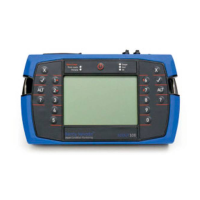General High amplitude peaks will appear at 1X,
2X, and sometimes 3X the running
speed. Look for a 180° (± 30°) phase
change across the coupling in the axial
direction (for angular misalignment) or
radial direction (for parallel, offset
misalignment).
Bearing misalignment (cocked bearing)
will cause a twisting motion in the axial
direction. Look for a 180° (± 30°) phase
change from the top to the bottom of
the bearing housing, or from one side to
the other.
Imbalance
General A high amplitude peak will appear at 1X
the running speed. Confirm that the
phase difference from horizontal to
vertical on the bearing is close to 90° (±
40°). The phase difference between left
and right horizontal locations should be
within 30° of the phase difference
between left and right vertical
locations. If the phase is unstable, there
may be another reason for a large
running speed vibration (e.g. looseness
or misalignment).
You can investigate the degree of
couple imbalance versus force
imbalance by looking at the phase
difference between the two sides of the
machine. If there is little couple
imbalance, only a single plane
correction may be required to balance
the rotor.

